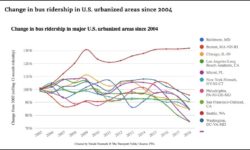New articles on Seattle
Politico has published a great account Has Seattle Found the Solution to Driving Alone to Work? Seattle voters made the decision to put their money into transit, on a big scale. It has paid off handsomely. Bay Area voters were cajoled instead to throw more money at highways. That will not turn out well. Streetsblog digs into solutions to the housing crisis with Seattle and Minneapolis: A Tale of Two Upzones. As these articles make clear, Northern California is not a center for innovation in the fields of transportation and housing.

